This roasted turkey breast with buttery garlicky flavors wears the crown on any holiday spread table, served among other appetizing sides and mains. And for very good reason. Baked turkey breast has tender and juicy meat inside, while the crust forms from a marinade of herbs, paprika, and olive oil.
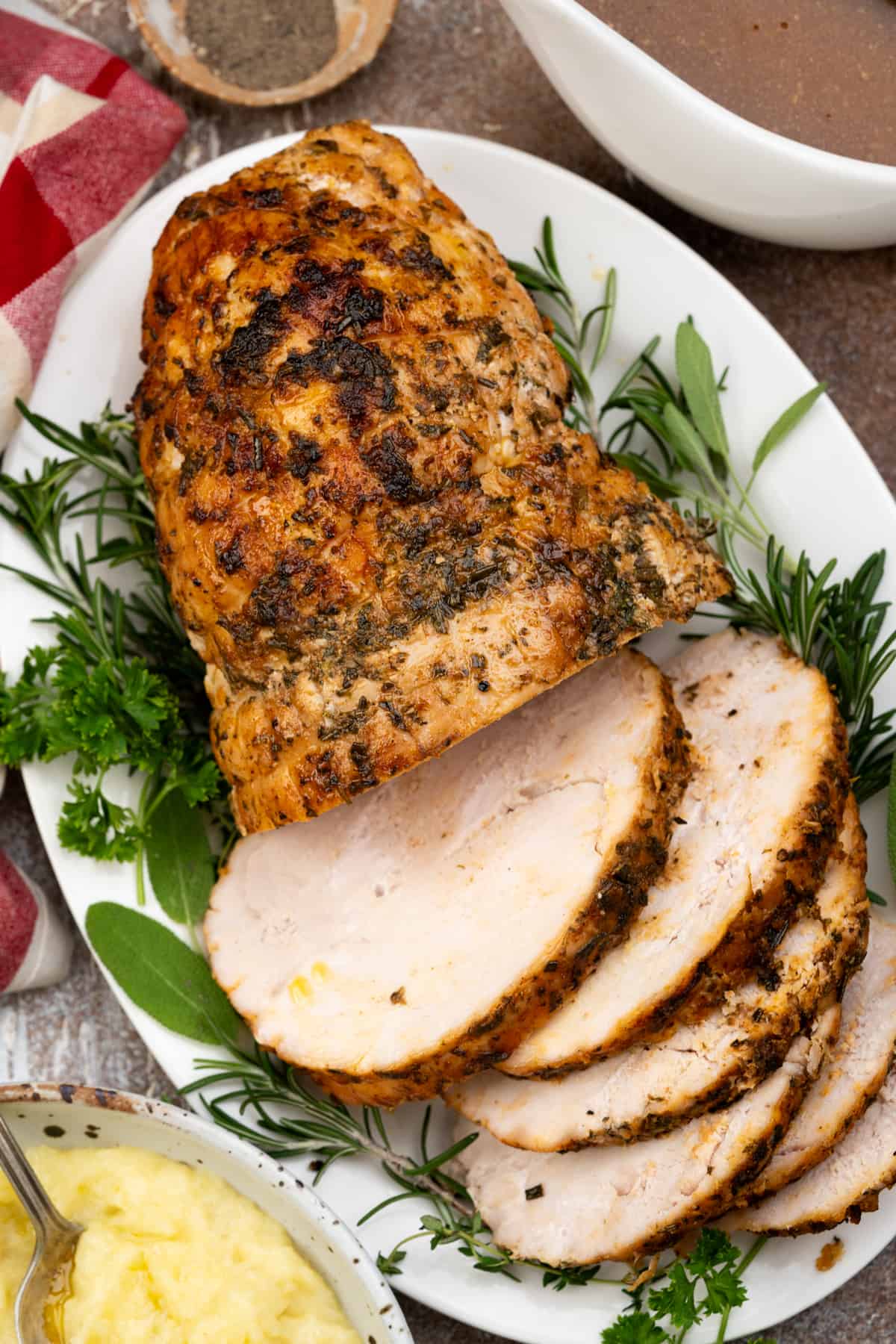
The culture of serving roasted turkey has spanned centuries and is a star attraction in Thanksgiving, Christmas, and holiday feast spreads. You cannot call it a festive feast without serving meat that can cater to a group. Turkey serves that purpose, with the baked breast being enough for a decent-sized group of diners.
Flavours In Your Inbox
Subscribe for recipes straight to your inbox
Even if you have never cooked a turkey before, this recipe guarantees you tender and juicy meat inside with a flavorful herby crust outside. For experienced turkey cooks, this is a classic dish but done with a flavor bang—with a herby mix on top of the butter and garlic, and get one that is so much better than the ordered turkey.
Garlic Butter Turkey Roast
Butter and garlic marinade is a classic marinade for most meats. But we do not stop at that. I have added chopped popular herbs like thyme, parsley, rosemary, and sage. This, when roasted in the oven, makes a delicious crust on top that complements the succulent meat underneath. You may even add a bit of lemon juice to add that citrusy flavor to the dressing.
The best part is that you do not make gravy to serve with this. The juicy drippings from the breast as it roasts, along with the marinade, white wine, and chicken stock, form the flavor base for the gravy on the pan. Fresh bulbs of onion and garlic that we place below the trivet on the pan further improve the aroma and flavor of the gravy. Just brush the turkey breast with this gravy before slicing, and you can also serve the breast slices with the gravy from the pan.
I have used skinless, boneless turkey, which is a very delicate and tender meat that cooks fast, is very easy to handle (rub the marinade over), and tastes juicy and delicious. You can use bone-in turkey breasts by giving them some more time to cook. The bone-in cuts get added flavor from the marrow and cartilage.
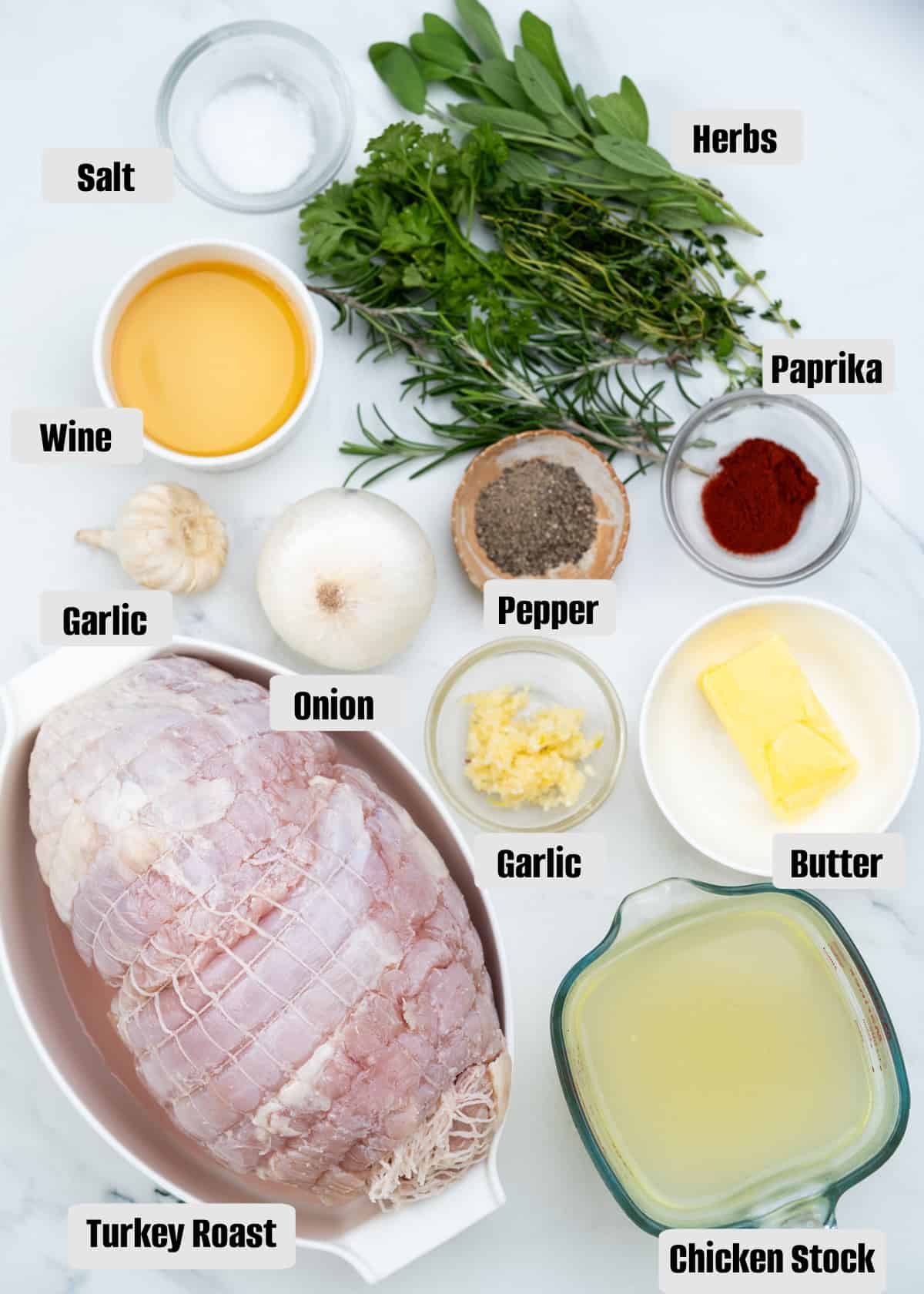
Ingredients
- Boneless turkey breast: I have used one skinless, boneless turkey breast. Get one large enough for your gathering, estimating roughly 1/2 pound for each guest. Spending on a good cut from a good butcher is very rewarding.
- Garlic: We need minced garlic from 4-5 cloves along with one whole bulb.
- Unsalted butter: some recipes make the marinade with just olive oil, but butter adds serious flavor, especially when stuff is roasted. Unsalted butter added with olive oil keeps the surface moist during roasting while adding a luxurious and velvety texture to the marinade.
- Olive oil contributes a fruity and peppery flavor while helping the butter increase its smoking point. Butter, when exposed to cold temperatures, tends to solidify and become lumpy, and this is where olive oil helps by keeping the marinade smooth and workable.
- Mixed herbs: four herbs that create a medley of flavors: sage, rosemary, parsley, and thyme. Together, they bring the herby, earthy taste from rosemary and thyme, freshness from parsley, and peppery notes from sage.
- Smoked paprika gives that smokiness to any roast and a slight spiciness. You may use regular paprika or chili powder too.
- White wine: the acidity in the wine improves the flavor.
- Chicken stock makes a savory base for the gravy. Vegetable stock may be used instead.
- Onion: quarter cuts of an onion bulb along with the garlic give an aromatic flavor to the gravy as it cooks along with other ingredients of the gravy.
- Salt and pepper balance the other flavors and improve everything.
How to roast herb-spiced turkey breast in the oven
- If frozen, thaw the turkey breast in the refrigerator the previous night. Take it out a couple of hours before the roast.
- Prepare the marinade by mixing the melted butter and other ingredients in a bowl. Rub them all over the turkey breast. Reserve a little of the marinade.
- Pour the white wine and chicken stock into the baking pan. Place the quartered onion pieces and halved garlic bulb on the pan with the wide side down. Place a trivet in the middle of the pan and shift the turkey breast onto it. Spoon some of the remaining marinade on top again. Stick the thermometer into the thickest part of the breast.
- Shift the baking pan to the oven and let it roast for an hour and a half. Keep basting it after every half hour. When the internal temperature reads 160°F, remove the baking pan from the oven. Allow the turkey to rest for 20 minutes.
- While the turkey rests, you can make the gravy. Add the remaining white wine to the baking pan that already has the caramelized garlic and onion pieces. Scrape the browned bits stuck to the pan that have lots of flavor. Mix well.
- In a saucepan, heat the butter and add it to the flour and rosemary. Stir well while the mixture cooks to make a roux. Place a coriander above the saucepan, and pour the liquid from the baking pan into the coriander. Squeeze the onion and garlic pulpy bits to drain the flavor into the filtered liquid. Let the sauce simmer and cook to your desired consistency.
- Using a sharp knife or scissors, remove the casing and slice. Serve with turkey gravy and your favorite sides.
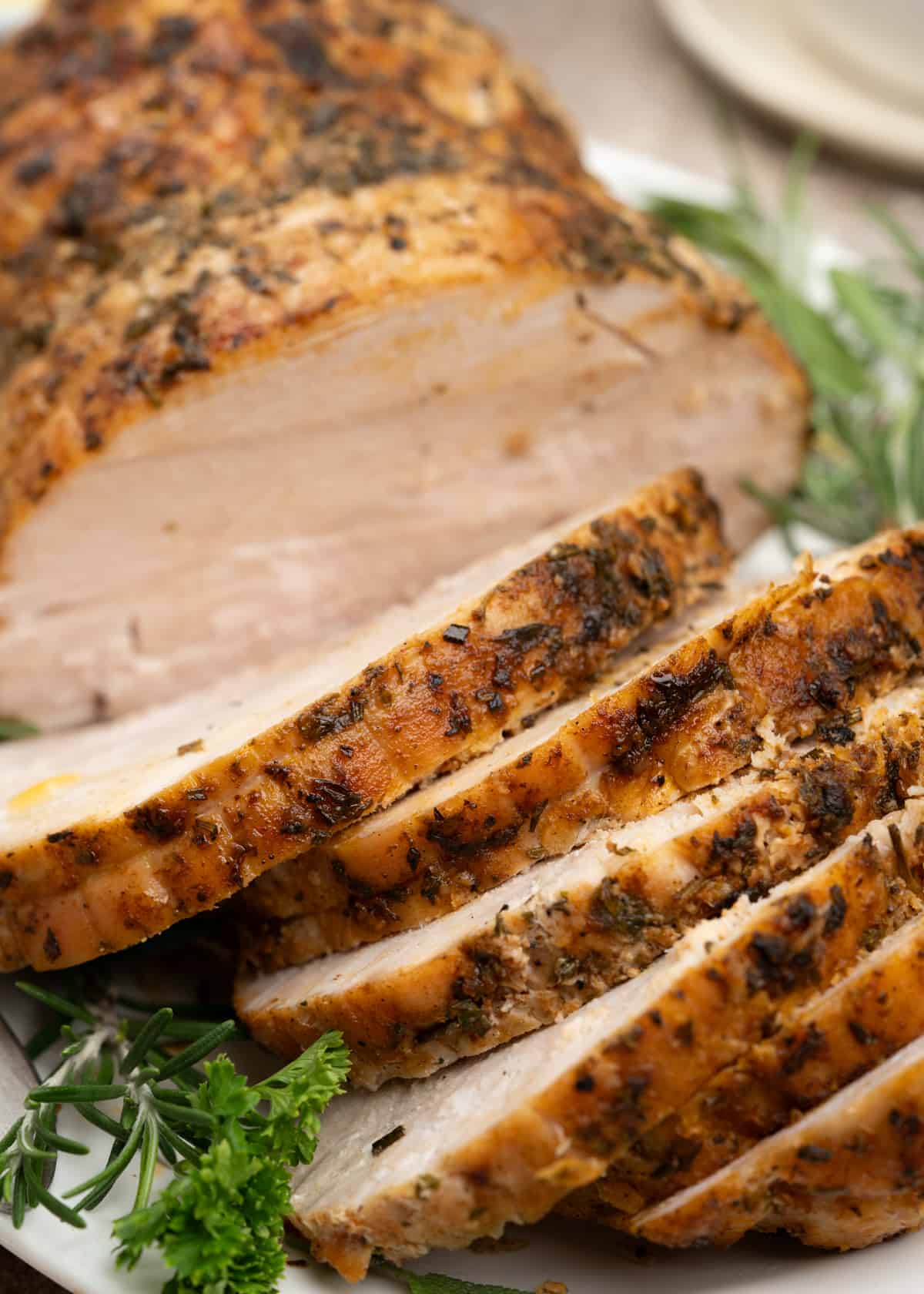
Tips for the best-roasted turkey breast
- Don’t remove the net. The net holds the meat together, so it cooks evenly.
- Frozen turkey roast sometimes comes with brine, in that case, adjust the salt.
- Get the best-quality turkey breast that you can afford. This is worth spending money on.
- Thaw the turkey breast for enough time. For frozen turkey, shift it to the refrigerator the previous night or 48 hours prior. You can even marinade the turkey while it thaws in the refrigerator, allowing it to absorb the flavors from the herby, buttery, and garlicky marinade. Thaw it at room temperature for at least 30 minutes before roasting.
- Invest in a kitchen thermometer. Getting the juiciest and tenderest turkey depends on the thickest part of the turkey breast reaching the right temperature. A thermometer makes the process fail-safe and convenient for you. Insert the thermometer at the thickest part and set the desired temperature before you start roasting in the oven. It sets an alarm and notifies you when the middle of the breast reaches the desired temperature.
- Baste, baste, and more basting. This step alone ensures that the turkey remains moist and gains more flavor when you keep basting it at regular intervals while it roasts.
- When you take the turkey breast out of the oven, keep it covered and allow it to rest for 20 minutes. While resting, the internal temperature rises further by another 20°C, which keeps cooking the turkey and allowing it to retain the juices. You get the juiciest and most tender turkey breast.
Storage instructions
Roasted turkey breast can be refrigerated and consumed within 4 days. If you freeze it, it is good for up to 3 months.
- Resting: Allow the turkey to rest until it comes to room temperature if you are planning to store it.
- Refrigerate: You can store the leftover gravy in a container. Wrap the turkey breast with foil or shift the slices to an airtight container and refrigerate it for 3 days.
- Freezing: You can freeze for much longer, up to 3 months. Wrap the turkey with heavy-duty foil, mark the date, and shift it to the freezer.
- Reheat: Baste the turkey breast with the leftover gravy. Insert the kitchen thermometer and shift the turkey breast to the oven. When it reheats, the middle of the breast should come to 165°F (74°C). This ensures that the turkey has cooked optimally and that its inside is tender and juicy again.
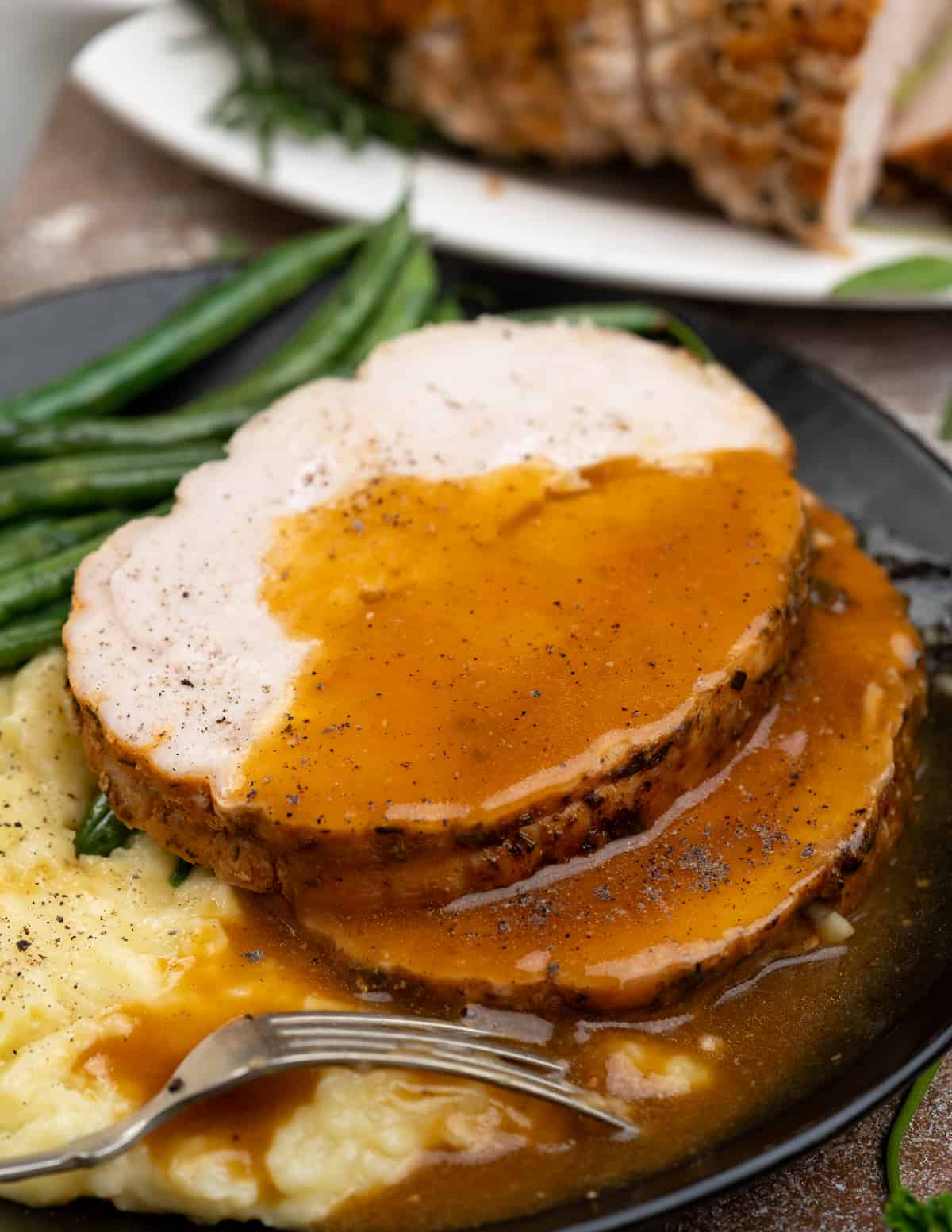
Serving suggestions
Along with the flavorful gravy made on the pan with the roast turkey breast, this highlight dish can be served with a variety of sides and appetizers on the dinner table.
Sliced turkey breast is best served with potato dishes like mashed potatoes, skillet potatoes, or Hasselback Potatoes. Classic options include sauteed green beans and Green Beans with Bacon.
Other great options are creamy salads like Creamy Carrot Salad, Red Potato Salad, or Fall Roasted Sweet Potato Salad, or even light vinaigrette-based salads like White bean salad, Apple Kale Salad, Couscous Salad With Orange Vinaigrette.
The versatility of turkey comes in handy when you can use leftover turkey in sandwiches, burgers, or wraps.
Other dishes to include in a dinner spread
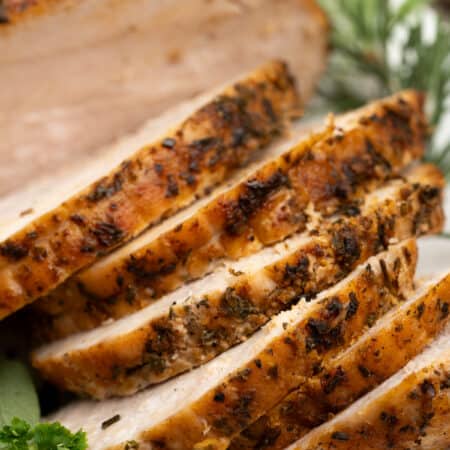

Boneless Turkey Breast Roast
Boneless Turkey breast marinated in garlic herb butter and roasted until it has a golden crust and juicy tender on the inside.
- Preheat oven to 350 degrees F.
- If the turkey breast is frozen, thaw it in the refrigerator 48 hours before cooking. Then on the day of cooking remove the turkey and thaw it completely. Pat dry well with a kitchen towel.
- Mix warm melted butter, olive oil, finely chopped herbs, paprika, salt and pepper. Mix well. Rub the turkey roast all over with marinade. Reserve a couple of teaspoons of marinade to use later(in step 5).
- Prepare a 9X13 baking pan. Add 1.5 cups of chicken stock and 1/2 cup of wine to the baking pan. Place quartered onions and halved garlic cut side down.
- Place a small trivet ( I used the one from my Instant Pot) at the center of the pan and keep the seasoned turkey breast on top of the trivet. Smear the reserved marinade on top.
- Bake uncovered for 1 hour 20-30 minutes. Bast the turkey once after 45 minutes of baking. Check with a meat thermometer, the thickest part of the meat should read 160 degrees F.
- Remove the casserole dish from the oven and keep the turkey covered for atleast 15 minutes before cutting it.
For Turkey Gravy
- The baking pan should have about 1/2 cup of remaining stock along with beautifully caramelized onions and garlic. Add remaining 1 cup of chicken stock to the baking pan. Scarp the bottom of the pan to release any brown bits.
- In a saucepan, heat 2 tablespoons of butter. Add 2 whole sprigs of rosemary followed by 2 tablespoons of flour. Saute flour until the raw smell is gone. Reduce to lowest heat.
- Place a colander on top of the saucepan and add all the liquid from the above baking pan along with onions and garlic. Press onion and garlic against the mesh with the back of a spatula to squeeze out the roasted garlic flesh into the gravy. ( watch the recipe video attached)
- Remove the colander and stir well. Simmer and let it cook for 3-4 minutes. The mix should start to thicken up. Remove the rosemary sprigs. You can run the gravy in a colander again for silky smooth turkey gravy.
- Using a sharp knife or scissors, remove the casing and slice. Serve with turkey gravy and favourite side.
- Don’t remove the casing. Casing holds the meat together and helps in uniform cooming. It is also cleaner to slice the turkey. But make sure to remove every bit of the casing before serving.
- Keeping the turkey on top of a trivet helps the bottom of the turkey to cook well without being soggy. If you don’t have a trivet, then make a bed of quartered onions and garlic and place the turkey breast on top of that.
- Adding white wine to the baking pan before roasting adds flavor to the turkey but you can absolutely skip it.
Serving: 1serving | Calories: 238kcal | Carbohydrates: 3g | Protein: 34g | Fat: 9g | Saturated Fat: 3g | Polyunsaturated Fat: 1g | Monounsaturated Fat: 4g | Trans Fat: 0.2g | Cholesterol: 93mg | Sodium: 385mg | Potassium: 445mg | Fiber: 0.2g | Sugar: 1g | Vitamin A: 232IU | Vitamin C: 1mg | Calcium: 28mg | Iron: 1mg
[ad_2]
